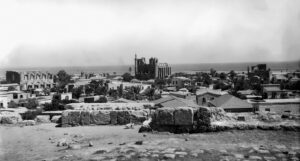The Moghabghab Family in Cyprus, New York and Madeira, 1878-1974
Nicholas Stanley-Price first encountered the name of Theophilus Mogabgab when doing archaeological fieldwork in Cyprus for his doctorate from Oxford University. His career since then has been mainly in international organizations dedicated to cultural heritage preservation. He lives in Rome, Italy.
The name of Theophilus Mogabgab (1886-1965), a native of Famagusta in Cyprus, was well known to Cypriots and to visitors to the island. He became an authority, entirely self-taught, on the history of the ancient walled town of Famagusta and impressed the many visitors whom he

guided with his enthusiasm and extraordinary knowledge of the place. As a surveyor / draughtsman trained in Beirut, he worked initially for the Railways Department and then the Lands Registration and Survey Department of the Cyprus government. In 1935 he transferred to the newly founded Department of Antiquities, with responsibility for the Famagusta District, and spent the rest of his career in this role. [1]
Many archaeologists who have made use of Mogabgab’s work have wondered what was his background. How did this man seemingly of Syrian-Lebanese origin come to be in Cyprus?
Most of his own records were destroyed during the war in Cyprus in 1974 (see below). But crucial information can be found in correspondence and documents of his younger brother Emile (1895-1947) who moved from Cyprus to the United States in 1920. Twenty years later he compiled a detailed Personal History Statement which appears to have been an application for US citizenship. [2] The information in this statement, supplemented by sporadic family correspondence and by other, external sources, leads to the following reconstruction of this family’s experiences in the Lebanese diaspora.
The father of Theophilus and Emile, Amin Halil Moghabghab, was born around 1851 in Ain Zhalta on Mount Lebanon. The family were adherents of the Melkite Greek Catholic church but converted to Protestantism after Amin’s father came across some Protestant evangelical literature. Amin studied at the Syrian Protestant College in Beirut, obtaining medical qualifications, and in 1879 accepted a position in Cyprus which had just recently come under British administration. He had a successful career as a Health Officer in the Famagusta District, a popular figure known as ‘Dr Araby’ who travelled throughout the district on a white stallion, administering every kind of medical treatment. [3] He retired in 1919 and died in 1923, leaving five surviving children, all born in Cyprus to their mother Anne who was a Syrian adopted as a child by an English lady. Of the five, Theophilus was the oldest; one of them, Mary, died young.

Theophilus spent his whole career in Cyprus, eventually changing the transliteration of his father’s name to ‘Mogabgab’. But his siblings left the island. In New York Emile found a job importing handmade embroidered linens from the Portuguese island of Madeira. He also met Vera Way (1900-1995), born in Wesley, Iowa, and brought up across the border in Waterton, SD. In 1931 they married in Cheltenham, England (the Mogabgabs were British subjects) but only after Emile had agreed to change his surname which Vera did not like. By deed poll he took a new surname ‘Marghab’, the name of the Crusader fortress (also “Margat”) on the Syrian coast near Baniyas but also not too different from his birth-name. The Moghabghabs, according to Emile, claimed Crusader ancestry – this helps explain also Theophilus’s motivation in researching the Lusignan Crusader monuments of Famagusta and proudly guiding visitors around them.
Emile learned the linens trade in Madeira while working there first with the L. Tweel Importing Co. House, and later with F.M. Jabara and Bros. He then set up his own business which he eventually co-managed with his wife who proved a shrewd business partner. In 1934 they opened a branch in New York as Emile Marghab Inc. Marghab linens acquired an international reputation for their quality. Examples are held in the permanent collection of the Metropolitan Museum of Art in New York.
There had been thousands of economic migrants from Mount Lebanon following the collapse of the silk industry there [4]. As Emile had, so too his younger brother Anice (1897-1974) found employment with Syrian emigrés who were continuing the same line of business abroad. Anice left Cyprus, accompanied by their sister Mathilde (‘Mattie’), and worked for twelve years in China exporting silk to the USA. In China he was employed by another New York-based Syrian business, Saydah & Saydah, Inc. with offices in Swatow (Shantou) and Shanghai. In 1937 his employers summoned him to New York. He and Mathilde stopped en route in Cyprus to stay with Theophilus, the first time they had seen each other for many years. Mathilde remained in Cyprus with Theophilus while Anice proceeded to New York, not sure whether his boss (Q.W. Saydah) was about to sack him. Instead, Emile made him a working partner in Emile Marghab Inc. On his first visit to the Marghab office in New York, Anice met their import/export manager, Winifred Stevenson, invited her out to dinner, and a year later married her.
Today there is no Mogabgab / Marghab presence in either Cyprus or Madeira. Emile Marghab fell ill in 1947 and, having been converted at Vera’s insistence to her own Christian Scientist faith, did not receive any medical treatment. Following his death in New York, Vera continued to manage the business but it steadily declined in changing market conditions. The memorial to her and Emile’s work is a complete collection of Marghab linens, together with an archive of family memorabilia, rare books and business and personal correspondence, which is now at the South Dakota State University. [5]

In Cyprus Theophilus retired in 1952 but continued with his antiquarian studies. His sister Mathilde outlived him, dying in 1970. Neither of them had married. They had lived in the family house at Karaolos, situated near the coast just to the north of the old town of Famagusta. By the 1970s this had become potentially very valuable real estate on the doorstep of the seaside resort of modern Famagusta. Theophilus was a keen collector and had filled the house with antiques, furniture, books and art. With Mathilde’s death, Anice in the States was the sole surviving sibling and duly inherited Karaolos. He and his wife Winifred decided in 1972 to retire and live there, selling their home in the US. Two years later during the coup d’état and Turkish invasion of Cyprus, the couple were evacuated by the US Navy to Beirut but the house’s contents were completely looted in their absence. Anice died in England a few months later, unaware of the house’s fate. [6]
Anice, the last of the Mogabgab siblings, had found himself unexpectedly an evacuee in Beirut, the city from which his father had emigrated to Cyprus almost 100 years earlier. Desperate for money to travel to England, his wife pleaded with a Beirut bank to cash her American personal check. The bank manager saw on the check the Mogabgab name which, by coincidence, was also his own name. Anice was evidently a distant cousin. He immediately approved the check for cashing. [7]
_______________________
- Nicholas Stanley-Price, “Theophilus Mogabgab of Famagusta, a ‘Saracen architect’ in British colonial Cyprus”, Cahiers du Centre d’Études Chypriotes 50 (2021, in press).
- Vera Way Marghab collection MA 25. South Dakota State University Archives Special Collections, Hilton M. Briggs Library, Brookings, South Dakota. My thanks to Michele Christian, Archivist and Special Collections Librarian, for making this material available to me.
- Winifred S. Mogabgab, Reminiscences of Winifred Stevenson Mogabgab: oral history, 1976, transcript, Columbia Center for Oral History, 1977.
- Akram Khater, Why did they leave? Reasons for early Lebanese migration.
- Biographical Note, in Vera Way Marghab collection (note 2 above); South Dakota Art Museum
- Winifred S. Mogabgab, Reminiscences (note 3 above), p. 38.
- Winifred S. Mogabgab, Reminiscences (note 3 above), p. 36.
- Categories:


